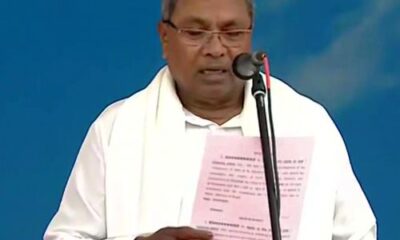Health/medicine
Rs 3K cr spent on free meds, tests to 25 lakh TB patients annually: Mandaviya
New Delhi, Feb 12 (IANS) The government spends approximately Rs 3,000 crore annually on free medicines, testing, and nutrition for 25 lakh tuberculosis (TB) patients in India, Union Health Minister Dr Mansukh Mandaviya said on Monday.
“Under the Prime Minister’s TB Free India Campaign, every year 25 lakh TB patients of the country are provided free medicines, testing, nutrition etc., in which approximately Rs 3,000 crore is spent annually,” he said in his virtual address to the 5th Foundation Day celebration of National Cancer Institute (NCI) of AIIMS, Jhajjar.
“Apart from this, financial assistance of Rs 500 per month is also given to TB patients, in which Rs 2,756 crore has been paid directly into the accounts of the patients in the last 5 years,” the minister added.
He also highlighted that 10 lakh TB patients of the country are being adopted by service-minded citizens, who are also distributing nutrition to them every month.
India aims to eliminate TB by 2025, five years ahead of the global target of 2030.
Manadaviya also mentioned the Sickle Cell Elimination Programme of the government in which sickle cell screening of about 7 crore people will be done in 3 years and medicines for sickle cell will be made available for free, on which the government will spend about Rs 910 crore.
Further, he noted that to ensure that everyone gets healthcare facilities with the same quality standard, “the government has worked in the last 10 years by linking the health sector with development”.
Mandaviya also lauded the achievements of the Ayushman Bharat PM-JAY and Ayushman Arogya Mandir scheme, which he said has not only saved the lives of crores of people but has also kept them from falling below the poverty line.
“By providing family health insurance of Rs 5 lakh annually to 60 crore people of the country, free treatment for serious diseases has been provided. Under this scheme, today even the poor get their treatment in those hospitals where earlier only rich people used to get their treatment. Till now, more than 6 crore people have received treatment under this scheme, due to which these poor people have saved more than Rs 1,12,500 crore.
“One of the purposes behind establishing over 1.64 lakh Ayushman Arogya Mandirs is to ensure that primary cancer screening is done in the first stage itself. Today, complex operations are being conducted in district hospitals as well,” he added.
The Health Minister also launched the AIIMS-SBI Smart Payment Card, which will ensure hassle-free payments for treatment in AIIMS, New Delhi.
“The AIIMS Smart Payment Card will resolve the long pending issue of patients from far flung areas carrying cash with them to the hospital,” he said.
He added that patients or their caretakers can get the card easily from the facilitation centres across AIIMS, New Delhi and thereafter use it for payment at various counters.
–IANS
rvt/vd
Health/medicine
Unicef seeks $16.5 mn for mpox response in Africa
Nairobi, Aug 22 (IANS) The United Nations Children’s Fund (Unicef) on Thursday appealed for $16.5 million to scale up mpox response in east and southern Africa.
UNICEF Regional Director for Eastern and Southern Africa, Etleva Kadilli, said in a statement issued in Nairobi, the capital of Kenya, that the new strain of mpox is a serious threat to vulnerable children and families, Xinhua news agency reported.
Children and vulnerable communities are on the verge of an expanding outbreak of mpox in the region as 200 confirmed cases have been detected across Burundi, Rwanda, Uganda, Kenya, and South Africa, the statement said.
“Aside from immediate lifesaving response, risk communication efforts and cross-border collaboration, investments in overall health system strengthening, continuity of essential services and targeted focus on programs that support overall child well-being must be prioritised,” Kadilli said.
The UN children’s agency warned concerns are rising over new public health emergencies as communities grapple with other ongoing crises. It said the new variant of the mpox virus (clade Ib) has been detected in all affected countries except South Africa, which is causing concern due to its potential for wider transmission across age groups, particularly young children.
Burundi has so far confirmed more than 170 mpox cases in 26 out of the 49 districts in the country, Unicef said.
It noted that children and adolescents aged below 20 years constitute nearly 60 per cent of cases detected, with children under five years old comprising 21 per cent of cases.
Kenya, Burundi, and Uganda have been struggling with multiple emergencies, including drought and floods, in addition to the immediate concerns posed by the virus, Unicef said.
The UN agency also warned concerns remain over the secondary impact of mpox outbreaks on children and adolescents, including stigma, discrimination, and disruptions to schooling and learning.
“Drawing from experiences gained during responses to HIV, Covid-19, and Ebola outbreaks, there must be a collective effort to prioritise plans for supporting survivors, combating stigma, and facilitating continuity of basic social services, especially learning and children’s reintegration into school and community,” Unicef said.
–IANS
int/jk/khz
Health/medicine
Ozempic and the uncomfortable truth
New Delhi, Aug 22 (IANS) Ozempic, the diet pill that took the world by storm has been under the public scanner for long, is found to be more devastating than what was originally speculated.
A study conducted at St. Vincent’s University Hospital (SVUH) in Dublin has challenged the prevailing belief that weight loss medications like Ozempic, Wegovy, or Monjaro primarily work by promoting satiety and reducing food intake.
The randomised controlled trial, led by Professor Donal O’Shea of SVUH and the UCD School of Medicine, involved 30 patients and focused on medications based on the hormone Glucagon-like peptide-1 (GLP-1).
The findings, published today in the Journal of the Obesity Society, reveal a strong relationship between increased metabolic activity caused by daily GLP-1 treatment and the amount of weight lost.
Interestingly, individuals with lower metabolic activity before beginning treatment experienced the most significant benefits.
“This study challenges the main narrative about these newer treatments, which is that they simply make you eat less and that any action on energy burn is minimal,” said O’Shea.
“The strength of the association is surprising given the relatively small number of participants, suggesting that this increase in metabolic activity is a significant contributor to how these drugs work.”
O’Shea emphasised the importance of understanding the full mechanism behind these treatments.
“Safe medical treatment for obesity is still in its infancy, and we need to fully understand how the treatment works. Understanding how these agents increase energy burn should be an important part of future research. The diet industry has been long criticised for the bilge and inhumanity it churns out in the name of making people slimmer, with the people in the public eye being the highest targets for it, actors, models etc, some of them being candid about their struggles to maintain the size zero figure. Studies like these throw a light on the uncomfortable part of pop culture.”
–IANS
ts/khz
Health/medicine
Kolkata hospital horror: SC asks WB Police to not disrupt peaceful protests, CBI probe to continue

New Delhi, Aug 22 (IANS) The Supreme Court on Thursday asked the West Bengal Police not to disrupt the peaceful protests in the wake of the horrific incident at Kolkata’s R.G. Kar Medical College and Hospital, where a trainee doctor was raped and murdered earlier this month.
“We categorically reaffirm that peaceful protests shall not be disturbed and disrupted. The state shall not take any action against those who are peacefully protesting against the incident at state-run RG Kar Medical College and Hospital,” a bench presided over by CJI D.Y. Chandrachud said.
The Bench, also comprising Justices J.B. Pardiwala and Manoj Misra, told senior advocate Kapil Sibal, representing the West Bengal government, that the apex court has not injuncted the state police from exercising such lawful powers as entrusted in terms of law, clarifying that the protestors should also comply with the requirements of the law.
“Let the investigation continue,” it remarked, taking on record the status report filed by the Central Bureau of Investigation (CBI) as well by the Kolkata Police in relation to the vandalisation of the hospital premises on the night of August 14.
The Supreme Court also asked the jurisdictional court to decide, by 5 p.m. on Friday, the application of the investigative agency seeking permission for a polygraph test of the accused.
Further, it asked the National Task Force (NTF), set up by the government on its direction, to give a hearing to diverse medical associations while formulating effective recommendations relating to the safety, working conditions and well-being of doctors and medical professionals.
“To facilitate filing of suggestions before the NTF, we direct the Secretary in the Union Ministry of Health and Family Welfare to open a specific portal on the website of the ministry on which associations and different stakeholders may submit their suggestions for consideration before the committee,” the SC ordered.
Urging medical professionals across the country to return to work, the apex court assured the resident doctors and interns that no adverse action would be taken against them for participating in protests.
During the hearing, the CJI-led Bench observed: “Ask them (doctors) first to return to work. Once they return to work, nobody is going to take adverse action against the doctors. Let them first come back to work and then, if there is any difficulty, we will make sure that no adverse action is taken against the doctors.”
It added that “the poor people coming to hospital cannot be left behind in the lurch” and raised concerns about how public health infrastructure would run if doctors did not resume work.
The SC reiterated: “Let all doctors resume work. Please rest assured that once the doctors resume duty, then we will prevail upon the authorities to not take any adverse action.”
Asking all the state governments to address the safety concerns of doctors and medical professionals, the apex court directed the Union Ministry of Health & Family Welfare to convene a meeting with all the Chief Secretaries and Director Generals of Police within a period of one week.
–IANS
pds/vd
Health/medicine
University doctors probe eye changes in Polaris Dawn mission
New Delhi, Aug 22 (IANS) In order to better understand the changes that astronauts’ eyes undergo during spaceflights, doctors at Augusta University’s Medical College of Georgia (MCG) are working with Polaris Dawn, the first of three human spaceflight missions under the Polaris Program.
More than 70 per cent of astronauts experience these alterations, which are a component of a syndrome known as Spaceflight Associated Neuro-Ocular Syndrome (SANS), according to NASA.
SANS can cause a variety of symptoms, ranging from severe vision loss to the requirement for glasses.
In addition to advancing human spaceflight capabilities, the Polaris Program seeks to raise money and awareness for significant Earthly issues.
As a result of changes in bodily fluids like cerebrospinal fluid (CSF), which can result in structural alterations in the brain, astronauts may suffer changes in their vision as early as their first day in space, according to Dr. Matt Lyon, Director of the MCG Center for Telehealth.
While CSF floats upward in space and presses against the optic nerve and retina, gravity on Earth aids in its removal from the optic nerve sheath.
By using portable handheld ultrasound scanners, Lyon’s team hopes to identify the astronauts who are most vulnerable to SANS and comprehend the mechanisms underlying these alterations.
A technology first developed to explore the effects of high cranial pressure and mild traumatic brain injuries (TBIs), MCG has trademarked the idea of utilising portable ultrasound to visualise damage from pressure and fluid changes in the optic nerve sheath.
A $350,000 NIH funding enabled the researchers to work with URSUS Medical Designs LLC to build a 3-D ultrasound device.
Currently, astronauts are being screened with this technology to check for optic nerve sheath damage or incompetence, which Lyon believes could predispose them to SANS.
The crew of Polaris Dawn is being trained by the research team to utilise these ultrasonic instruments to assess fluid and pressure in real time while in orbit.
Determining whether the changes in vision are due to pressure, fluid volume, or both will aid in the development of countermeasures.
Using a lower-body negative pressure device, which draws bodily fluids downward, could be one way to mitigate the danger of SANS during space flights.
–IANS
ts/rad
Health/medicine
Number of COVID-19 patients in S Korea shows signs of abating

Seoul, Aug 22 (IANS) The number of patients hospitalised for COVID-19 showed signs of abating, health authorities said on Thursday.
Although the weekly number of COVID-19 inpatients grew last week, the growth rate of hospitalisation plunged, according to the Korea Disease Control and Prevention Agency (KDCA), Yonhap news agency reported.
The number of COVID-19 patients in 220 hospitals last week came to 1,444, up 5.7 per cent from a week earlier, the KDCA said.
That compared with 1,366 patients in the second week of this month, up 55.2 per cent from a week earlier, and 880 patients in the first week, up 85.7 per cent from a week ago.
“Considering the current trend, the number of infections is expected to decrease after this week or the next,” KDCA Commissioner Jee Young-mee said during a meeting with related government agencies.
Jee added that the number of infections this week, previously estimated at 350,000, would likely be “smaller than anticipated.”
The KDCA also announced that it has completed the purchase of 260,000 doses of COVID-19 treatments using a reserve fund of 326.8 billion won (US$244.8 million), with 177,000 doses set to be available at local pharmacies starting Monday next week.
To prevent the spread of the virus among students, the government has issued guidelines to schools ahead of the new semester, including requiring students to take leave if they exhibit severe COVID-19 symptoms, for the last COVID-19 pandemic had rattled the strongest of economies and health care systems, leaving a devastating image in its wake, something that not even the two World Wars could match.
South Korea remains vigilant and in good spirits but it can always look back and realise that it can never be too vigilant.
–IANS
ts/dan
-
Video2 years ago
PM Modi Attacks Congress in Karnataka with “Kerala Story”
-
Politics2 years ago
Siddaramaiah & DK Shivakumar sworn in as Chief Minister & Deputy CM respectively
-
Cricket2 years ago
CSK players rejoice 5th IPL title with their families (Pics)
-
Entertainment2 years ago
Karan Deol weds his longtime Girlfriend Drisha Acharya (Pics)
-
Sports7 years ago
History Of Official FIFA WORLD CUP Match balls
-
India2 years ago
Ashwini Vaishnaw: Railway Board recommends CBI probe in the Odisha railway disaster
-
Entertainment2 years ago
Urvashi Rautela dazzles on Cannes 2023 red carpet (Pics)
-
Entertainment2 years ago
Sunny Leone gets ready for Kennedy premiere in Cannes (Pics)





























